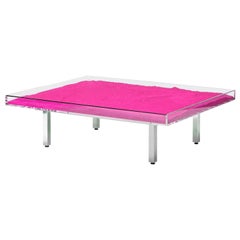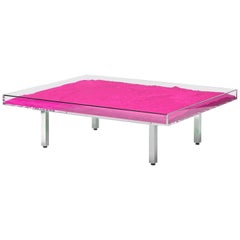Pink Yves Klein Table
2010s French Modern Coffee and Cocktail Tables
Stainless Steel
Recent Sales
2010s French Modern Coffee and Cocktail Tables
Stainless Steel
2010s French Modern Coffee and Cocktail Tables
Stainless Steel
People Also Browsed
Vintage 1960s Italian Post-Modern Vanities
Metal, Brass
2010s American Mid-Century Modern Wall Lights and Sconces
Brass, Nickel, Enamel, Bronze
21st Century and Contemporary Portuguese Modern Sofas
Velvet, Walnut
21st Century and Contemporary Portuguese Modern Benches
Velvet, Wood, Ebony
21st Century and Contemporary Portuguese Modern Benches
Velvet, Wood, Lacquer, Fabric
21st Century and Contemporary Brazilian Modern Armchairs
Bouclé
Vintage 1970s Italian Mid-Century Modern Bedroom Sets
Steel, Chrome
Vintage 1920s Danish Scandinavian Modern Bookcases
Mahogany
Vintage 1970s Italian Mid-Century Modern Sectional Sofas
Metal
2010s Finnish Modern Lounge Chairs
Fiberglass
21st Century and Contemporary French Mid-Century Modern Sofas
Stainless Steel
20th Century American Mid-Century Modern Sofas
Metal, Brass
21st Century and Contemporary Italian Mid-Century Modern Sectional Sofas
Silk, Velvet
21st Century and Contemporary Cabinets
Plywood
21st Century and Contemporary Italian Modern Sofas
Foam, Wood
21st Century and Contemporary American Sofas
Bronze
Yves Klein for sale on 1stDibs
French artist Yves Klein is best known for his trademark ultramarine pigment, which he patented as International Klein Blue in 1961. “Blue … is beyond dimensions, whereas the other colors are not,” he said.
“All colors arouse specific ideas, while blue suggests at most the sea and the sky; and they, after all, are in actual, visible nature what is most abstract.”
Starting in the mid-1950s, Klein made retinal blue monochrome paintings (which would prove cornerstones of Minimalism) and the pigment would also feature prominently in his Anthropometry paintings, for which Klein smeared nude women with blue pigment and used them as human brushes on canvas, sometimes in elaborate public performances. Klein's work anticipated Conceptual art, performance art and environmental art, as in his selling of portions of empty space to collectors. For The Void (1958), he presented an empty gallery as an artwork, wearing a white tie and tails to show visitors around the blank walls.
Find authentic Yves Klein sculptures, prints and other art on 1stDibs.
A Close Look at Modern Furniture
The late 19th and early 20th centuries saw sweeping social change and major scientific advances — both of which contributed to a new aesthetic: modernism. Rejecting the rigidity of Victorian artistic conventions, modernists sought a new means of expression. References to the natural world and ornate classical embellishments gave way to the sleek simplicity of the Machine Age. Architect Philip Johnson characterized the hallmarks of modernism as “machine-like simplicity, smoothness or surface [and] avoidance of ornament.”
Early practitioners of modernist design include the De Stijl (“The Style”) group, founded in the Netherlands in 1917, and the Bauhaus School, founded two years later in Germany.
Followers of both groups produced sleek, spare designs — many of which became icons of daily life in the 20th century. The modernists rejected both natural and historical references and relied primarily on industrial materials such as metal, glass, plywood, and, later, plastics. While Bauhaus principals Marcel Breuer and Ludwig Mies van der Rohe created furniture from mass-produced, chrome-plated steel, American visionaries like Charles and Ray Eames worked in materials as novel as molded plywood and fiberglass. Today, Breuer’s Wassily chair, Mies van der Rohe’s Barcelona chair — crafted with his romantic partner, designer Lilly Reich — and the Eames lounge chair are emblems of progressive design and vintage originals are prized cornerstones of collections.
It’s difficult to overstate the influence that modernism continues to wield over designers and architects — and equally difficult to overstate how revolutionary it was when it first appeared a century ago. But because modernist furniture designs are so simple, they can blend in seamlessly with just about any type of décor. Don’t overlook them.
Finding the Right Coffee-tables-cocktail-tables for You
As a practical focal point in your living area, antique and vintage coffee tables and cocktail tables are an invaluable addition to any interior.
Low tables that were initially used as tea tables or coffee tables have been around since at least the mid- to late-1800s. Early coffee tables surfaced in Victorian-era England, likely influenced by the use of tea tables in Japanese tea gardens. In the United States, furniture makers worked to introduce low, long tables into their offerings as the popularity of coffee and “coffee breaks” took hold during the late 19th century and early 20th century.
It didn’t take long for coffee tables and cocktail tables to become a design staple and for consumers to recognize their role in entertaining no matter what beverages were being served. Originally, these tables were as simple as they are practical — as high as your sofa and made primarily of wood. In recent years, however, metal, glass and plastics have become popular in coffee tables and cocktail tables, and design hasn’t been restricted to the conventional low profile, either.
Visionary craftspeople such as Paul Evans introduced bold, geometric designs that challenge the traditional idea of what a coffee table can be. The elongated rectangles and wide boxy forms of Evans’s desirable Cityscape coffee table, for example, will meet your needs but undoubtedly prove imposing in your living space.
If you’re shopping for an older coffee table to bring into your home — be it an antique Georgian-style coffee table made of mahogany or walnut with decorative inlays or a classic square mid-century modern piece comprised of rosewood designed by the likes of Ettore Sottsass — there are a few things you should keep in mind.
Both the table itself and what you put on it should align with the overall design of the room, not just by what you think looks fashionable in isolation. According to interior designer Tamara Eaton, the material of your vintage coffee table is something you need to consider. “With a glass coffee table, you also have to think about the surface underneath, like the rug or floor,” she says. “With wood and stone tables, you think about what’s on top.”
Find the perfect centerpiece for any room, no matter what your personal furniture style on 1stDibs — shop Art Deco coffee tables, travertine coffee tables and other antique and vintage coffee tables and cocktail tables today.


